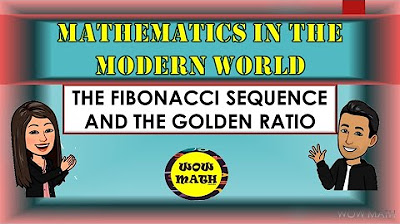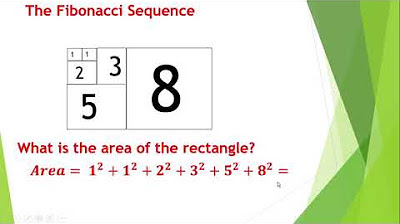Mathematics - Fibonacci Sequence and the Golden Ratio
Summary
TLDRThis educational video delves into the Fibonacci sequence and the Golden Ratio, explaining how each term in the sequence is the sum of the previous two. It demonstrates the convergence of ratios between successive Fibonacci numbers towards the Golden Ratio, approximately 1.618. The video also covers the mathematical derivation of the Golden Ratio through the Fibonacci sequence and introduces a formula for calculating any term in the sequence. It concludes with insights into the geometric properties of the sequence, such as the approximation of the geometric mean by middle terms for large 'n'.
Takeaways
- 🔢 The Fibonacci sequence starts with 0 and 1, with each subsequent term being the sum of the previous two.
- 🌟 The Golden Ratio is the limit of the ratios of successive terms in the Fibonacci sequence, approximately equal to 1.618.
- 📈 As 'n' increases in the Fibonacci sequence, the ratio of successive terms approaches the Golden Ratio.
- 🔄 The sequence can be used to approximate the next term by multiplying the previous term by the Golden Ratio (1.618).
- 🔄 The reciprocal of the Golden Ratio (approximately 0.618) can be used to approximate the previous term in the sequence.
- 🧮 The exact value of the Golden Ratio can be calculated using the formula ((sqrt(5) + 1) / 2), which results in 1.618.
- 🔢 A formula to calculate any term in the Fibonacci sequence is given by f_n = ((sqrt(5) + 1)^n - (-sqrt(5) + 1)^n) / (2^n * sqrt(5)).
- 🔄 The Fibonacci sequence behaves like a geometric sequence for large values of 'n', where terms are proportional to powers of the Golden Ratio.
- 🔍 The Fibonacci sequence's properties can be derived from the quadratic equation r^2 - r - 1 = 0, leading to the Golden Ratio.
- 📘 The video provides a comprehensive overview of the Fibonacci sequence and the Golden Ratio, including their mathematical derivations and applications.
Q & A
What is the Fibonacci sequence?
-The Fibonacci sequence is a series of numbers where the first two terms are 0 and 1, and each subsequent term is the sum of the previous two terms.
How is the Fibonacci sequence defined mathematically?
-Mathematically, the Fibonacci sequence is defined as f(n) = f(n-1) + f(n-2) for n >= 2, with initial terms f(0) = 0 and f(1) = 1.
What is the Golden Ratio?
-The Golden Ratio, often denoted by the Greek letter phi (φ), is the limit of the ratios of successive terms in the Fibonacci sequence, approximately equal to 1.618033988749895.
How does the Golden Ratio relate to the Fibonacci sequence?
-As the Fibonacci sequence progresses, the ratio of successive terms approaches the Golden Ratio, which is the limit of f(n) / f(n-1) as n approaches infinity.
What is the formula for calculating the nth term of the Fibonacci sequence?
-The formula for calculating the nth term of the Fibonacci sequence is f(n) = ( (sqrt(5))^n - (-sqrt(5))^n ) / (2^n * sqrt(5)).
How can you estimate a term in the Fibonacci sequence using the Golden Ratio?
-You can estimate a term in the Fibonacci sequence by multiplying a known term by the Golden Ratio raised to the power of the number of steps you want to advance in the sequence.
What is the significance of the number 0.618 in relation to the Fibonacci sequence?
-The number 0.618 is the reciprocal of the Golden Ratio and is used to approximate the previous term in the Fibonacci sequence when n is very large.
Can you use the Golden Ratio to find terms in the Fibonacci sequence beyond the 12th term?
-Yes, for large values of n, the Golden Ratio can be used to approximate terms in the Fibonacci sequence by using the formula f(n) ≈ f(n-1) * φ^(n-1).
How is the Golden Ratio derived from the Fibonacci sequence?
-The Golden Ratio is derived from the Fibonacci sequence by considering the ratio of consecutive terms and taking the limit as the term number approaches infinity, which results in the quadratic equation r^2 - r - 1 = 0.
What is the geometric interpretation of the Fibonacci sequence when n is large?
-When n is large, the Fibonacci sequence approximates a geometric sequence, where each term is approximately the previous term multiplied by the Golden Ratio.
Outlines

This section is available to paid users only. Please upgrade to access this part.
Upgrade NowMindmap

This section is available to paid users only. Please upgrade to access this part.
Upgrade NowKeywords

This section is available to paid users only. Please upgrade to access this part.
Upgrade NowHighlights

This section is available to paid users only. Please upgrade to access this part.
Upgrade NowTranscripts

This section is available to paid users only. Please upgrade to access this part.
Upgrade NowBrowse More Related Video

EMODULE 1.2 - The Fibonacci Sequence

THE FIBONACCI SEQUENCE AND THE GOLDEN RATIO || MATHEMATICS IN THE MODERN WORLD

Unit 1 | Lesson 3: The Fibonacci Sequence (Mathematics in the Modern World)

The Fibonacci Sequence

Fibonacci Sequence

What is the Fibonacci Sequence & the Golden Ratio? Simple Explanation and Examples in Everyday Life
5.0 / 5 (0 votes)